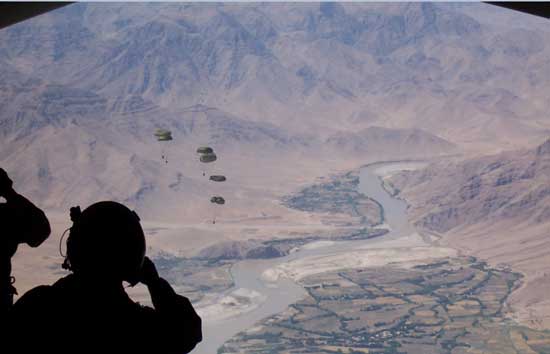During our visit to Transcom in March 2010, General McNabb provided a detailed overview on the challenges in supporting the deployed warfighter in Afghanistan, including supporting the surge ordered by the President. Although the General did not put it this way, it was apparent that the con-ops approach of Transcom is providing a very good fit with the nature of the Afghan challenge. The multi-modal approach of Transcom provides an appropriate match to the Afghan support challenge.
On the one hand, the multi-modal approach is built around using diverse delivery means calibrated against the required speed of delivery to the warfighter. And within this context seeking as cost effective approach as possible. The command is clearly seeking to shape more effective data measures and decision-making tools to assist in managing trade-offs among alternative delivery means.
On the other hand, Afghanistan as a land-locked country can be supported for military operations only through air and ground transport systems. Sea-delivery can provide a significant bulk of supplies but these need to be moved the last miles by air and ground systems. Also, important is diversifying the axis of supplies to manage the risk factor of disruption of supply through any one means. And the diversification requirement fits hand in glove with the multi-modal approach.
The General discussed several axis points into Afghanistan being used by Transcom.
The first route is the “Pakistan ground lines of communication. These routes have zero % military C2, are 100% commercial, involve all host nation trucking and are projected to carry 54,000 containers per year.”
The second route is the so-called Northern Distribution Network. “This year we have had 8327 containers on the ND with 5172 coming via the Russian route and 3155 via the Caucasus Route.”
The third route moves cargo from Iraq to Afghanistan via Turkey or the NDN and “is moving 300-400 containers per month”.
The fourth route is the Trans-Siberian variant of the NDN route. This route opens the “US West Coast and Pacific for shipment with a refrigerated cargo capability and a potential for 400-500 TEUs per month.”
A fifth route is the use of a polar route, which “allows us to move troops to fly non-stop and saves 2-8 hours of flight time per mission. The use of this fully is pending Kazakhstan approval of new routings.”
A major element of delivery of goods is via airdrops directly to deployed forces. “Although costly, this mode is essential for a deployed and distributed force. There is a significant increase in millions of pounds of delivered goods via this route from 16 million in 2008 to 29 million in 2009.”
The air delivered element is significant given the nature of the theater of operation. Normally, 90% of military requirements are shipped by sea and 10% by air; in Afghanistan the balance is different with 80% by sea and 20% by land.
And several innovations have been demonstrated within Afghanistan in performing airdrops. The airdrop approach allows the deployed forces to move directly on their operations without carrying a deployed warehouse; “they can have valet delivery in route which facilitates operational tempo and enhanced security for the deployed forces.”
The main tools facilitating airdrops in Afghanistan are as follows: Joint Precision Air Drop System, GPS rigged JPADS bundle, Improved Container Delivery System (ICDS-HV) dropped above threat envelope, improved container delivery systems, and disposable chutes providing slow descent at low altitude.
 A key aspect of managing the Afghan supply effort has been the improved data available through the Defense Transportation System. General McNabb underscored that the “enhanced transparency of data allows us to have much better knowledge of where the choke points are in the system and allows us to seek improvements and identify work arounds.”)
A key aspect of managing the Afghan supply effort has been the improved data available through the Defense Transportation System. General McNabb underscored that the “enhanced transparency of data allows us to have much better knowledge of where the choke points are in the system and allows us to seek improvements and identify work arounds.”)
Another aspect of improved ability to track flows of goods and to identify anomalies, which might in reality be significant pilfering in the system has been the use of satellite tracking systems. Satellite ITV on the PAKGLOC allows reporting at less than 20-minute intervals with no gaps in satellite coverage. There is automatic connectivity to the government database. All of this allows Transcom with greater ability to measure carrier performance and has led to “less than 1% of the containers in shipment being pilfered or damaged.”
General McNabb underscored that a key to success in Afghanistan clearly is to be able to provide an effective system of supply. “This is central to our ability to succeed in both military and security operations. And is clearly a capability, which differentiates us from earlier efforts to operate within Afghanistan. Logistics is the core for sustained operations; and the diversified approach we are taking to supply is central to success in this effort.”
———-
***Posted On July 15th, 2010


